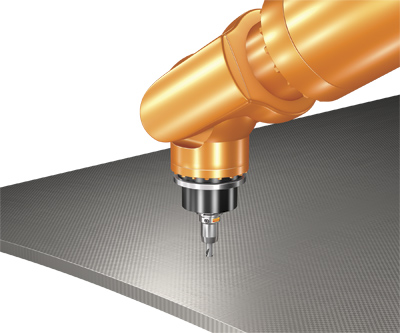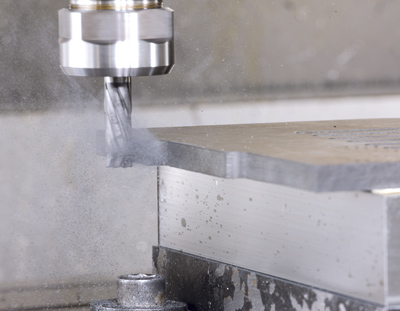by Mary Scianna
Composites use continues to grow but still poses machining challenges
Metal and composites share one thing in common: they’re ubiquitous materials found in products we use everyday from household appliances and civil infrastructure to components in vehicles and aircraft. Unlike metal however, with the exception of some specialty alloys, composites pose more machining challenges. And as the market for composites continues to grow–demand is expected to reach $12 billion by 2020 in the US alone with growth being driven by aerospace, transportation and construction industries–cutting tool suppliers are focusing more R&D on tooling to meet the unique needs of manufacturers that handle composite materials.
Tackling challenges
Anyone who is involved with machining of composites is familiar with the challenges they pose, but if you’re new to the material and need to know what to expect, suppliers who spoke with Shop Metalworking Technology Magazine have some advice.
The biggest challenge is to first understand what you’re dealing with. Composites are typically stacked materials, which means you dealing with different materials with different properties.
“Cutting tool designs have to change dramatically when you’re dealing with composites,” says Craig Bastian, general manager for IT.TE.DI. North America, an IMC Group company based in Rockford, IL. The Italian cutting tool company, which opened its North American headquarters in July 2014, specializes in PCD and CBN custom tools and milling cutters. “When you get into machining of stacked materials, you may be looking at a material with CFRP sandwiched between
a layer of aluminum and titanium and now you need one tool that effectively overcomes the challenges of different materials.”
These stacked composites present some key problems that shops entering this market must consider.
Problem 1: Delamination
Delamination is one of the biggest issues you’ll encounter when machining composites, says Jay Ball, Seco Tools’ product manager, solid carbide end mills for the NAFTA region. The machining cycle can generate stresses on the composites and cause layers to separate and compromise the material’s integrity.
Scott Feimster, a regional manager with LMT Onsrud, adds “these are materials that by design are heat resistant and if you can’t take away the heat from the part it stays present with the tool and then you introduce wear challenges. And if you reactivate the resin, it’s like glue that flows and you’re done. In recent years, some aerospace companies have introduced coolant to help with this and on the cutting tool side, suppliers have created new geometries to cut more freely. But when you do this, you also may create tooling that wears more quickly. A lot of thought has to go into the design of tooling for composites.”
 He cites the company’s solid carbide compression mills as an example. The tools feature upcut and downcut spiral flutes the compress the composite material to prevent delamination. The cutting edges have a high positive rake to provide quick clean shearing and keep heat to a minimum to prevent resin burn.
He cites the company’s solid carbide compression mills as an example. The tools feature upcut and downcut spiral flutes the compress the composite material to prevent delamination. The cutting edges have a high positive rake to provide quick clean shearing and keep heat to a minimum to prevent resin burn.
Seco Tools, a relative newcomer to the composites machining arena, according to Ball, has developed and patented a tool to address this issue. It took a right hand router style tool and designed it with a left hand helix. “We changed the prep of the tool to get it ready for accepting a diamond coating that chemically bonds to the carbide substrate. It’s not revolutionary, but what is key is that we’re able to control the diamond coating because the process is done within our group. If you can control the geometries, produce and control the carbide substrate and the coating, then you can become a market leader in this area.”
Ball says Seco sees great growth potential in the composites market. Indeed, he says with the new router alone, there’s potential for millions of dollars in sales annually with several accounts, including one in Canada.
Problem 2: Tool life
Suppliers concur that tool design–geometries, surface preparation and coatings–are critical to successful machining of composites. Carbide routers, drills and end mills with sharp edges, brazed PCD coatings and diamond coated carbide tips are all good options, but they’re not perfect solutions, warn suppliers.
 “The big thing suppliers are doing is focusing on maximizing tool life, improving productivity and reliability during machining of composites, says Seco’s Ball. “There are hundreds of carbide suppliers and not every carbide is the same and you’ll have different grades and different chemicals which results in different performance properties so you have to be careful selecting the right tooling for the right composite machining requirement.”
“The big thing suppliers are doing is focusing on maximizing tool life, improving productivity and reliability during machining of composites, says Seco’s Ball. “There are hundreds of carbide suppliers and not every carbide is the same and you’ll have different grades and different chemicals which results in different performance properties so you have to be careful selecting the right tooling for the right composite machining requirement.”
“We specialize in PCD because you can maintain a sharp edge, but some customers will not allow the use of coolant when machining composites so with brazed PCD, if you increase speed and generate too much heat, you risk melting the braze and creating problems” says Bastian of IT.TE.DI. North America. “So you need to run at slower speeds than normal for PCD to control the heat. And with diamond coated tools, you lose the sharp edge quicker than with a PCD tool, so you get edge strength at higher cutting speeds but shorter tool life.”
 McEachern says PCD tools have become popular because they offer “extended tool life, reducing the cost per hole in a manufacturer’s process. PCD tools are especially effective at machining multi-directional and uni-directional composites, materials that are growing in use in the aerospace sector.
McEachern says PCD tools have become popular because they offer “extended tool life, reducing the cost per hole in a manufacturer’s process. PCD tools are especially effective at machining multi-directional and uni-directional composites, materials that are growing in use in the aerospace sector.
An example is Sandvik Coromant’s PCD-veined cutting tools for drills, mills and end mills. According to the company, the tools are monolithic in structure, which means they can be ground with various geometries and features once thought difficult to achieve using conventional brazing methods. The tools combine the durability of a diamond with the versatility of carbide, according to Sandvik Coromant.
Problem 3: Eliminating dust
Machining composites generate dust. That dust isn’t just a hazard for workers, it’s a problem for tool life too, say suppliers. That’s because manufacturers may apply cutting fluids to lubricate tools and reduce heat in the work zone, but when you mix that coolant with dust, you generate an abrasive slurry. Some composites absorb water and may swell up. Suppliers such as Sandvik Coromant suggest cold air guns that can cool the workpiece and remove debris.
As the use of composite material continues to grow, chances are you may find yourself having to machine it. The best advice suppliers offer is to simply find the right cutting tool to meet your application needs. And when in doubt, talk to different cutting tool suppliers that may offer different solutions to your challenges. SMT
